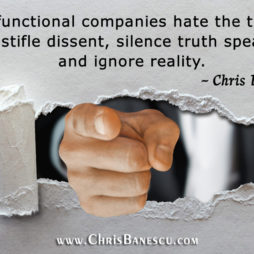 by Chris Banescu –
by Chris Banescu –
Here’s a list of dysfunctional, unethical, and destructive organizational practices that I have personally experienced or seen while working with or consulting for various companies, corporations, universities, and non-profit institutions. Each of these will demotivate employees, undermine their morale, and negatively affect their productivity. Each of them will corrode organizational cohesiveness, foment suspicion and resentment of management, and destroy employees’ trust in and respect of their leaders.
Once more than one of these dysfunctional situations become normalized and spread across a company, then employee dissatisfaction and disengagement will increase exponentially. Quality of work will be negatively impacted. Great employees will begin to leave. Then the good ones will quit. The remaining employees will stop caring, stop speaking out, stop trying to address problems or improve anything inside the company. They will “go to gray.” They will do the minimal work required of them and no more.
If this pathology continues over longer periods of time, a human resources crisis will envelop the entire company and disaster (financial, ethical, legal, criminal, etc.) will inevitably follow.
Great employees will begin to leave. Then the good ones will quit.
These practices are the exact opposite of how genuine leaders should ethically, fairly, capitalistically, and justly treat their employees. These behaviors make a mockery out of the universally true principle that an organization’s employees represent its most valuable resources!
None of these practices are taught in any business, management, leadership, or other academic course or program, as an ethical and effective way to lead and manage others. None of these practices have ever been proven to work in order to motivate employees, boost their morale, increase their loyalty and trust, raise their productivity, and help a company achieve long-term success or sustained profitability. Yet, managers and executives continue to adopt these “anti-human” strategies in order to “get the job done” or “make our numbers.”
If I didn’t know any better I would suspect these managers and executives studied some secret and dark “anti-management” or “anti-human leadership” book on how to destroy a company from the inside out.
How to Demotivate Employees and Undermine Morale and Productivity:
- Treat employees as if they are disposable.
- Make them feel powerless and insignificant.
- Remind employees that they can be easily replaced.
Treat employees as if they are disposable.
- Make them live in constant fear of losing their jobs.
- Practice unjustified favoritism and treat employees capriciously.
- Don’t listen to what employees have to say.
- Pretend to listen to what they say, then disregard it.
- Ignore employee helpful suggestions, innovative ideas, and constructive feedback, even when they can improve the company’s product(s) or service(s), enhance customer service, optimize processes, reduce costs, or increase profitability.
- Ask employees for feedback on organizational culture, problems, and suggested improvements, then promptly ignore them.
- Micromanage their work and constantly override their legitimate authority.
- Drown them in overbearing processes and bureaucratic procedures that give more power and control to managers, but create useless busy work for employees while contributing nothing to employee productivity or helping them complete work more efficiently and productively.
- Make promises you know you can’t keep or offer them opportunities that will never materialize.
- Create a multi-layered bureaucratic management hierarchy and pecking order based solely on status and power, and make it virtually impossible for front-line employees or managers to reach or communicate substantively with senior managers and executives.
Pay employees differently for doing the same work and/or similar productivity.
- Pay employees differently for doing the same work and/or similar productivity.
- Increase workloads and job responsibilities only for some employees, while pretending they won’t be doing more work and getting paid the same.
- Offer pay raises or cost-of-living increases only to some employees, while ignoring others who do the same work and contribute just as much to company profitability.
- Don’t give long-term employees any stake in the business.
- Don’t provide profit-sharing or other performance-based rewards to key employees, while giving them only to senior managers and executives.
- Pay them fixed salaries and require unlimited hours of work, even on the weekends.
- Thank employees for showing great initiative and delivering excellence or superior achievements (above and beyond their normal job responsibilities), but don’t give them any meaningful or valuable reward beyond the “thank you” email, card, plaque, cake, or balloons.
- Demand that employees sacrifice (lose benefits, take a pay cut, and/or work more for less pay) “for the good of the organization,” while executives pay, benefits, and bonuses stay the same or even rise.
Increase senior executives compensation regardless of the company’s overall performance and profitability.
- Increase senior executives compensation regardless of the company’s overall performance and profitability.
- Use a company’s poor performance, lower stock price, and/or stagnating or decreasing revenues or profitability, as an excuse/reason why employees won’t get raises or bonuses this year, while senior managers and executives still get raises, bonuses, profit sharing, or stock options.
- Don’t reassure employees in times of uncertainty, change, or crisis.
- Keep them in the dark about key organizational problems or upcoming layoffs.
- Punish all employees for the abuses or mistakes of a few.
- Promote a win-lose confrontational culture where employees are encouraged to achieve success and monetary gains at the expense of others.
- Divide and conquer, allow departmental in-fighting that destabilizes organizational cohesiveness and centralizes power in senior executives only.
Threaten employees with “be lucky you have a job” when they speak out
- Threaten employees with “be lucky you have a job” when they speak out about serious organizational issues or ask for help to address inequity or unjust organizational situations.
- Tell them “no one is forcing you to stay” or “you can always quit” when they point out unfair or inequitable work situations or ask for help dealing with an incompetent or abusive manager.
Does this sound familiar? Have you encountered similar or different dysfunctional situations in your workplace? How many of these practices did you witness? Feel free to share (anonymously if needed) your experiences in the Comments section below.





All too familiar in a corporate culture that rewards short term gains over the long term health of a company. I deem it as a “Too Big to Succeed” culture. Of course they all have somewhere written in their mission statement about how “Employees are our #1 resource.” That statement is technically true, but they don’t tell you they mean it the same way coal is the #1 resource in a fire-burning locomotive. Throw some on the fire until it burns out, then shovel some more in to keep that engine running.
You did leave one tool out that companies with this mentality will also use. Yes, great people will leave the company, but they will also FIRE selected great employees as a message to everyone else in the organization that, “thinking” is not to be tolerated.
John, Yes, you’re absolutely right they will purposely fire great employees to send a message, silence others, and scare the remaining employees into submission. I used to think these executives did this due to their incompetence, I now understand they did it purposely and maliciously. They are bonafide sociopaths and act accordingly.
The irony of all these “anti-human” abuses and short-term thinking is that long-term, sustainable, and healthy profitability can only be achieved by following an ethical approach, treating your employees and your customers as your most valuable assets, and providing true value to shareholders (owners), customers, and employees. The other kind of short-term “profitability” doesn’t work. It’s merely an illusion that allows abusive executives to maximize their compensation and leads to the company being destroyed from the inside for some unsustainable short-term gains to decorate shareholder reports.
Chris, thanks for the great article! You are absolutely right and it’s unfortunate this list can be so long without an organization even trying. As you said, it only takes a few employees to be upset for this to become an organization-wide issue. In addition, it only takes a few of these problems to multiply exponentially as well. Thanks for the reminders!
The person who showcased their skill as the CEO, and other executives were at the main office along with heads of a major television network watched, and within 15 minutes they had a check for $37 million in hand. (This was summer 1996) The person whose skills made it happen never got recognition. The dotcom was still in the early stages, and grew to 6,000 people that spanned the globe. The key person whose skill made that initial deal happen was asked for ideas many times, but without being reflected in pay/bonuses. As more people were hired for different roles, you were expected to mentor, but without extra $$. It was almost as if they were trying to replace someone in a higher pay grade. As the company experienced rapid growth, and thousands who desperately wanted to break into the business, one of the Einsteins came up with using ‘volunteers’ while dangling that carrot of “When we hire, it’ll be from the pool of volunteers who already trained.” Do you think any of the ‘volunteers’ was ever hired? There were people who worked 40 hr weeks at their PAYING job, and then would pick up volunteer hours, with many working for free anywhere from just a few hours per week to over 40. Why pay those who worked hard, when you have THOUSANDS working for free? Personally, I never dangled that carrot because it was morally reprehensible.
When the company had an IPO, those working at different levels were gifted stock, and gifted options. You could also purchase as long as you had a specific minimum net worth. This is where you wonder how some people who didn’t do much were given much more stock and options ( options were $0.02 and could be used 6 months post IPO). Of course, the volunteers didn’t get anything.
As the value of the company grew, the Senior execs began making trips to Europe, supposedly to acquire lucrative contracts. They left no stone unturned in London, Paris, Monaco, Rome. It was a grueling month. ? Meanwhile, senior execs are borrowing against the company. Some were borrowing $500K, $250K, etc. This had become their personal atm, all the while giving everyone the impression that things are going great, keep buying stock, because the company is doing fantastic! What the masses didn’t know was this was right about the time of the dot com bust. After 6 very fruitful years, the stock was down to pennies. Amazingly, no one ever repaid the ‘loans’ they gave to each other from the company’s liquid assets. About 6 months before that final day, major employee cuts were taking place. For those remaining, every few weeks, more and more were let go, until just a handful that weren’t at the main office remained. Morale had dropped to an all time low. Imagine how the ‘volunteer’ workforce felt after years of being misled with that dangling carrot.
On another occasion, you’ve come up with a perfect intro for online events, and also credits to run once that online event had finished. Imagine the surprise when someone else was given your copy and they not only used it, but you were approached for not only questions to ask, but your notes after taking the time to either read the book, research the topic, or know the sport, the music, or just about anything. It’s called plagiarism vs being asked to produce and share this information, but being given credit, and paid/reimbursed for the time you have invested.
There was so much more, but you get the idea.